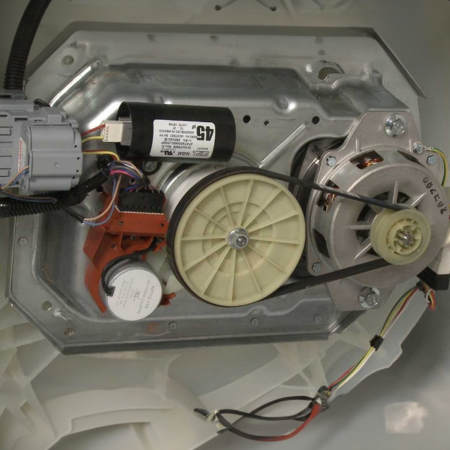A common issue that some owners of Whirlpool washing machines encounter is the Whirlpool washer not spinning.
This problem can disrupt the laundry process, leaving your clothes soaking wet at the end of a cycle.
This article will explore this issue in detail, outlining the potential causes and solutions.
From simple fixes you can carry out at home to situations where you might need professional assistance, we aim to guide you through each step.
By the end, you should better understand your Whirlpool washer’s spinning issue and know how to approach solving it.
Key Points
- Drain Pump or Hose Issues: Blockages in the drain pump or hose can prevent the washer from spinning. Regular maintenance and cleaning can help prevent this issue.
- Broken Lid Switch: If the lid switch is faulty, the machine may not spin. Replacing the lid switch can solve this problem.
- Worn Out Drive Belt: A worn or damaged drive belt can lead to spinning issues. Inspecting and replacing the drive belt if needed can help.
- Motor Control Problems: The motor control board issues can lead to the washer not spinning. You may need professional assistance to inspect and repair this issue.
5 Reasons Why Is Whirlpool Washer Not Spinning
Understanding the potential causes behind your Whirlpool washer’s spin issue can be the first step toward a solution. Let’s delve into five common reasons:
1. Unbalanced Load
An unbalanced load is a common reason for a Whirlpool washer not spinning.
It occurs when the laundry inside the washing machine is not evenly distributed.
Washers are designed to maintain balance during the spin cycle.
If the load is heavy on one side, the washer will remain stationary to prevent damage.
This feature, while protective, can disrupt your laundry routine.
Fixing an unbalanced load is easy. Simply open the washer mid-cycle.
Redistribute the laundry evenly. Then, restart the cycle.
Remember, it’s important to distribute the items in the washer evenly at the start of the cycle.
You can prevent an unbalanced load by not mixing heavy and light items.
For instance, avoid washing a heavy bath towel with light T-shirts.
Following these simple steps can help resolve and prevent unbalanced load issues.
This way, your Whirlpool washer can resume its normal spinning operation.
2. Lid Switch Fault
A faulty lid switch is another common issue.
The lid switch signals the washer to start spinning once the lid is closed.
If it’s malfunctioning, the washer won’t spin.
You can usually determine if the lid switch is faulty by listening.

When you close the lid, you should hear a clicking sound.
No sound could indicate a problem with the switch.
This issue might require professional help.
A technician can replace the defective switch with a new one.
Trying to replace it yourself can be risky.
You might accidentally damage other parts of the washer.
So, it’s best to leave this task to professionals.
Remember, safety should always be your top priority when dealing with electronic devices.
3. Worn Out Drive Belt
A worn-out drive belt is a common problem that can halt your washer’s spinning operation.
The drive belt connects the motor to the drum.
When it’s worn or broken, the motor runs, but the drum doesn’t spin.
This will prevent your clothes from being washed effectively.
You can find out if the drive belt is the culprit by checking it visually.
Turn off and unplug the washer first. Remove the rear panel of the machine.
Inspect the belt. Look for signs of wear, like cracks, fraying, or stretch marks.
A shiny underside could also indicate wear.
If the belt is in poor condition, it needs to be replaced. Replacement is relatively straightforward. However, if you’re uncertain about doing it yourself, seek professional help.
Remember, safety is paramount when dealing with electrical appliances.
A professional can ensure the job is done safely and correctly, guaranteeing the longevity of your appliance.
4. Damaged Motor Coupler
The motor coupler serves as a safety device for your washer. It protects your machine’s motor by breaking apart if the drum becomes overloaded or stuck. If the motor coupler is damaged, it can’t perform this vital function, causing your washer’s drum to not spin.
You’ll need to disconnect the washer from the power source to check the motor coupler. Be sure to follow safety guidelines when doing this to avoid electric shock.
Next, remove the cabinet of the washer to access the motor coupler. You’re looking for signs of damage, such as cracks or chips.
A broken motor coupler will need replacing. You can do this yourself if you’re comfortable and experienced with home appliance repairs.
However, it is recommended to hire a professional if you’re unsure. They have the necessary skills and tools to replace the motor coupler safely and efficiently.
As always, preserving your safety is more important than saving some money on repair costs.
5. Faulty Washer Motor
The washer motor is crucial for the operation of your machine. It drives the drum, allowing for the agitation and spinning necessary for cleaning clothes.
If the motor is faulty, the drum won’t spin.
Identifying a faulty motor can be challenging. It requires a multimeter to test the motor’s electrical components.

Start by unplugging the washer. Safety comes first.
Next, access the motor by removing the machine’s cabinet.
Using your multimeter, check the motor for continuity.
A lack of continuity indicates a problem with the motor.
In case of a faulty motor, replacement is the primary solution.
Attempting to fix a motor yourself can be risky. It involves handling complex electrical components.
Unless you’re experienced in this area, consider hiring a professional.
They can ensure a safe and effective motor replacement.
A properly functioning motor is essential for your washer’s performance.
Investing in professional repair can extend your appliance’s lifespan. It is worth the cost.
How To Troubleshoot Whirlpool Washer Not Spinning?
When troubleshooting your Whirlpool Washer, follow these steps:
- Start by unplugging your machine. Safety is paramount.
- Inspect the washer for obvious signs of damage. This includes any cracks or leaks.
- Check the lid switch. It should click when closed. If not, it might be defective.
- Examine the machine’s belts. They should not be broken or excessively worn.
- Look at the motor coupler. It should be intact, without cracks or chips.
- If you’re comfortable, test the washer motor with a multimeter. Continuity indicates a functioning motor.
- When in doubt, consult with a professional. They are trained to handle complex appliance repairs safely and efficiently.
Remember, a functioning washer is an asset. Professional repairs are an investment in the longevity of your appliance.
Frequently Asked Questions
1. What could be the reason for my Whirlpool washer not spinning?
It could be due to several reasons. One common cause could be a defective lid switch assembly. If the lid switch assembly fails, the washer will not spin. Another probable cause could be a worn-out drive belt.
If the belt is broken or if it isn’t tight on the pulleys, the washer won’t spin. Lastly, the motor coupling which connects the motor to the washing machine transmission can also fail, and then the machine won’t spin. Getting a professional technician to diagnose and resolve such issues is recommended.
2. Can a faulty lid switch cause my Whirlpool washer to stop spinning?
A faulty lid switch can cause your Whirlpool washer to stop spinning. The lid switch assembly is a safety feature that prevents the washer from spinning while the lid is open.
If this assembly is defective, it could inaccurately signal that the lid is open when it’s in fact closed, thereby preventing the spin cycle. As repairing or replacing the lid switch assembly involves dealing with electrical components, it’s best to have a professional technician handle such tasks.
Drive belts play a crucial role in the functioning of your Whirlpool washer. They transfer power from the motor to the drive system, enabling the washing machine to spin. However, over time, these belts can wear out or become loose.
If the drive belt is broken or if it isn’t tight on the pulleys, the washer won’t spin as it should. The belt must have the right tension and be in good condition to drive the spin cycle effectively. If you suspect a drive belt issue, it’s advisable to contact a professional technician for diagnosis and repairs.
4. Could the motor coupler potentially cause my Whirlpool washer not spinning?
The motor coupler could contribute to your Whirlpool washer not spinning. The motor coupler functions as a safety device, preventing the motor from severe damage if the transmission malfunctions or the drum becomes hard to turn. If it breaks, power from the motor won’t be transmitted to the transmission, disabling the spin cycle.
Typically, a broken motor coupler is characterized by a loud noise during the spin cycle, without any actual spinning. Due to the complexity of replacing a motor coupler, it’s highly recommended to engage a professional technician to handle such issues.
5. How does a faulty clutch impact the spinning function of my Whirlpool washer?
A faulty clutch can indeed affect the spinning function of your Whirlpool washer. The clutch assembly makes the connection between the transmission and the inner tub. It helps the tub gradually reach the proper spin RPM.
If the clutch is worn out, it may not be able to provide enough friction to spin the inner tub, thus causing it to spin weakly or not at all. A common sign of a faulty clutch is a scraping noise during the spin cycle. Contact a professional technician if you suspect a problem with the clutch.
Conclusion
Maintaining your Whirlpool Washer is vital. Regular checks can prevent major faults.
Unusual noises are warning signs. Don’t ignore them.
Detergent usage matters. Overuse can harm your machine.
Proper loading of clothes is essential. Overloading can cause damage.
Ensure a clean washer. It boosts appliance performance.
Look at the drain system. Avoid blockages. Use appropriate settings. They affect your machine’s lifespan.
Care for your washer. It will serve you longer. Remember, appliance care saves money in the long run.
Washer maintenance is a worthy investment. Don’t neglect it.
- Can You Scrap A Microwave And Why You Should? - May 13, 2024
- Can You Put Metal In A Convection Microwave: 10 Major Risks - May 12, 2024
- Can You Use A Microwave Without The Glass: 10 Benefits - May 11, 2024

